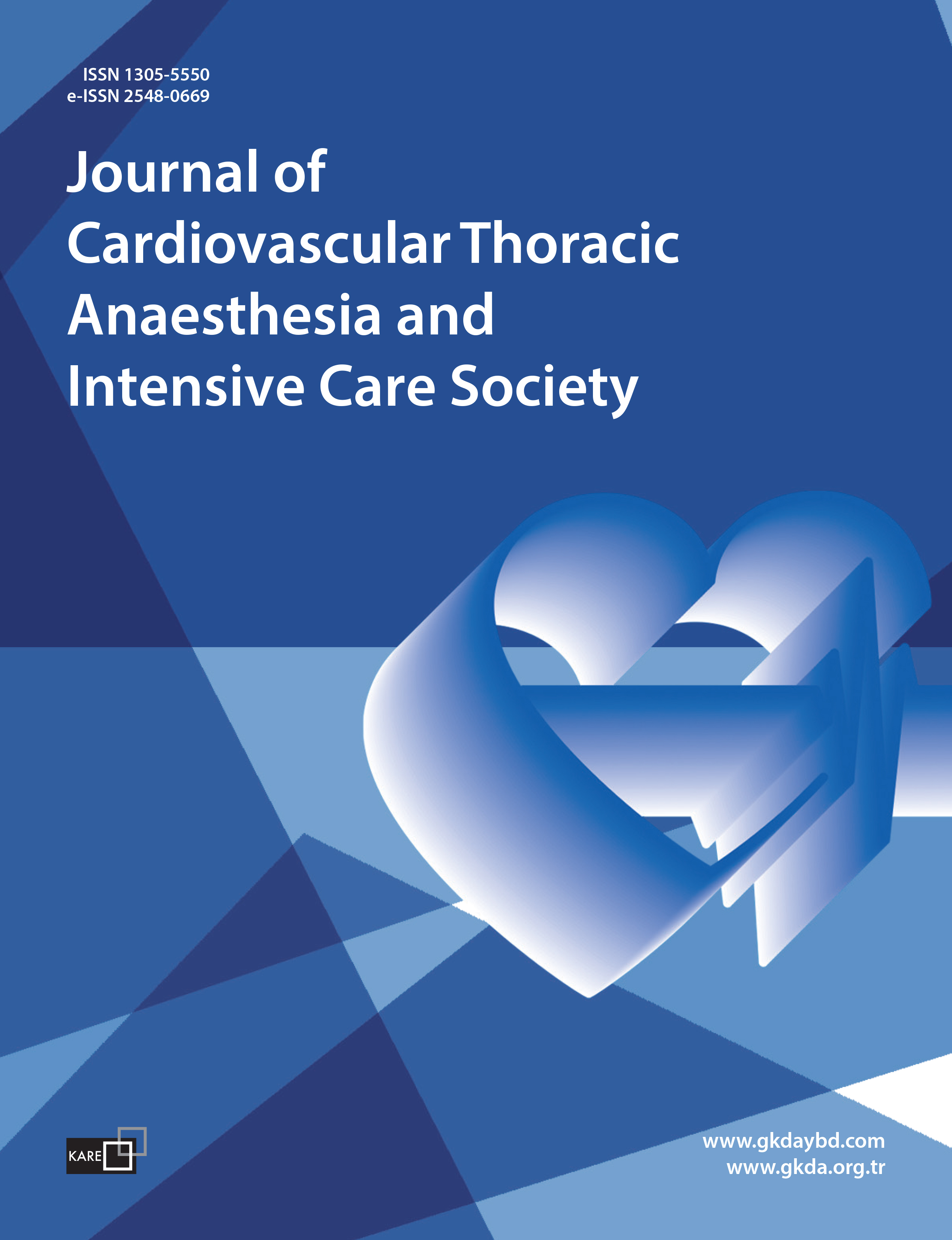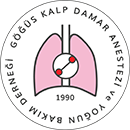

Volume: 21 Issue: 4 - 2015
| REVIEW | |
| 1. | The important points to anesthesiologist in cardiac physiology Zuhal Aykaç, Beliz Bilgili doi: 10.5222/GKDAD.2015.157 Pages 157 - 161 (3740 accesses) Uygulanan her anestezi hastaların fizyolojsini etkilemektedir ve özellikle en çok kardiyovasküler sistem etkilenmektedir. Bu nedenle kardiyovasküler sistem fizyolojisini anlamak, anestezi altında meydana gelen değişikliklerin daha iyi anlaşılabilmesine, olumsuz olayların zamanında ve etkin olarak tedavi edilebilmesine olanak sağlamaktadır. Bu derlemede, kalp fizyolojisinde anestezistler için önemli olan noktalara değinilmiştir. Anesthesia affects the physiology of each patient and most especially the cardiovascular system is affected. Therefore understanding the physiology of the cardiovascular system allows a better understanding of the changes occurring under anesthesia, enabling recognition and effective treatment of the adverse events. This review has addressed the points that are important to anesthesiologists in cardiac physiology. |
| EXPERIMENTAL WORK | |
| 2. | Comparison of thoracic epidural fenatanil, fentanyl / bupivacaine, fentanyl / ropivacaine or fentanyl / levobupivacaine for postthoracotomy analgesia Mustafa Şimşek, Türkan Kudsioğlu, Yasemin Altuntaş, Nihan Yapıcı, Zuhal Aykaç doi: 10.5222/GKDAD.2015.162 Pages 162 - 167 (1061 accesses) GİRİŞ ve AMAÇ: Torakal epidural analjezi (TEA) akciğer cerrahisi olgularında postoperatif ağrı tedavisi için kullanılan bir yöntemdir. Çalışmamızda torakotomi geçiren hastalarda postoperatif aneljezi için torakal epidural yöntemiyle fentanil ve birlikte verilen lokal anestezik ilaçların hemodinami ve ağrı skorları üzerine etkilerini karşılaştırdık. YÖNTEM ve GEREÇLER: Torakotomi geçiren 80 hasta 4 gruba ayrıldı. Postoperatif TEA için hasta gruplarına; fentanil + serum fizyolojik, fentanil + ropivakain, fentanil + bupivakain, fentanil + levobupivakain uygulandı. Hemodinamik veriler ve ağrı skorları kaydedildi. BULGULAR: Levobupivakainin fentanil ile kombinasyonu, ropivakain ve bupivakaine göre daha etkili analjezi sağladı. TARTIŞMA ve SONUÇ: TEA postoperatif dönemde hastanın yeterli solunum gücü ve akciğer ekspansiyonu için son derece önemlidir. Torakotomi gibi ağrılı girişim sonrası TEAde lokal anestezik fentanil kombinasyonu daha etkin analjezi sağladı. Levobupivakainin + fentanil analjezisinin diğer gruplara göre daha etkili olduğu görüldü. INTRODUCTION: Thoracic epidural analgesia (TEA) is a method used for postoperative pain management in thoracic surgery patients. In our study, in patients with postoperative TEA method thoracotomy, we compared the effects of fentanyl and local anesthetic drugs on hemodynamics and pain scores. METHODS: 80 patients undergoing thoracotomy were divided into 4 groups. In patients groups for postoperative TEA was administered fentanyl, fentanyl + ropivacaine, fentanyl + bupivacaine, fentanyl + levobupivacaine. Hemodynamic data and pain scores were recorded. RESULTS: Levobupivacaine in combination with fentanyl, providing a more effective analgesia compared to ropivacaine and bupivacaine. DISCUSSION AND CONCLUSION: TEA is extremely important for the patient's sufficient respiratory effort and lung expansion in the postoperative period. It was concluded that after many painful procedures such as thoracotomy in thoracic epidural use of fentanyl together with local anesthetics provides more effective analgesia. Compared to other groups levobupivacaine+fentanyl analgesia was more effective. |
| 3. | Our anesthesia experiences in pediatric congenital heart surgery: Preliminary results Nureddin Yüzkat, Muhammed Bilal Çeğin, Vural Polat, Lokman Soyoral, Uğur Göktaş, Alper Sami Kunt doi: 10.5222/GKDAD.2015.168 Pages 168 - 173 (3096 accesses) GİRİŞ ve AMAÇ: Konjenital kalp hastalığı nedeniyle açık kalp cerrahisi geçiren pediyatrik vakaları incelemek YÖNTEM ve GEREÇLER: Kasım 2013 ile Mart 2015 tarihleri arasında konjenital kalp cerrahisi geçiren pediyatrik vakalar retrospektif olarak incelendi BULGULAR: Olguların 17i erkek, 23i kız idi. Bu olguların %52,5i yenidoğan idi. Tüm olguların %50sinde cerrahi işlem kardiyopulmoner bypass eşliğinde yapıldı. CPB eşliğinde cerrahi uygulanan olguların %75ine kan kardiyoplejisi, %25ine histidine-tryptophan-ketoglutarate solution kullanıldı. TARTIŞMA ve SONUÇ: Pediyatrik kalp cerrahisine yeni başlayan bir merkezde anestezik açıdan karşılaşılan problemler; deneyimli tekniker, yeterli medikal ve tıbbi malzeme ve kateterizasyon işlemleri karşılaşılabilen zorluklar olmuştur. INTRODUCTION: To investigate pediatric cases undergoing open heart surgery due to congenital heart disease. METHODS: Pediatric cases undergoing congenital open heart surgery between November 2013 and March 2015 were retrospectively reviewed. RESULTS: 17 of the cases were male and 23 of them were female. 52.5% of these cases were newborns. Surgery process was performed with cardiopulmonary bypass in %50 of all cases. %75 of the cases operated with CBP were applied with blood cardioplegia while %25 of them were applied with the histidine-tryptophan-ketoglutarate solution. DISCUSSION AND CONCLUSION: Anesthetic problems encountered in a new pediatric cardiac surgery centers were: lack of experienced technicians, medical supplies, and catheterization procedure problems. |
| CASE REPORT | |
| 4. | The Use of Total Intravenous Anesthesia During Rigid Bronchoscopy And Balloon Dilatation in The Treatment Of Tracheal Stenosis: A Report of 4 Cases Canan Salman Önemli, Deniz Ayhan Çatal doi: 10.5222/GKDAD.2015.174 Pages 174 - 179 (2003 accesses) Trakea stenozu konjenital, edinsel ve idiopatik nedenlerle oluşan bir havayolu obstrüksiyonudur. En sık görülen etyoloji ise entübasyon veya trakeostomiye bağlı uzamış mekanik ventilasyondur. Entübasyona bağlı trakeal stenoz, endotrakeal kaf basıncının trakea mukozası ortalama kapiller-arterioler kan basıncını aşması sonucu oluşur. Girişimsel bronkoskopik yöntemler özellikle son yıllarda seçilmiş hastalarda düşük komplikasyon oranları nedeniyle hem tanı hem de tedavide kullanılmaya başlanmıştır. Özellikle genel anestezi altında uygulanan rijit bronkoskopide hızlı bir anestezi indüksiyonu ile kontrollü bir havayolu ve ventilasyon sağlanarak güvenli bir müdahale yapılabilir. Bu yazıda entübasyona bağlı trakeal stenoz gelişen dört olguda rijit bronkoskopi eşliğinde yapılan balon dilatasyon uygulamasında total intravenöz anestezi yönetimi sunulmuştur. Tracheal stenosis is airway obstruction caused by congenital, acquired and idiopathic. The most common etiology is intubation or tracheostomy due to prolonged mechanical ventilation. Tracheal stenosis due to intubation occurs as a result that the endotracheal cuff pressure exceeds the mean capillary-arteriolar blood pressure in tracheal mucosa. Interventional bronchoscopic procedures have commonly used in recent years for both diagnosis and treatment because of low complication rates in selected patients. In particular, by rapid induction of anesthesia, it is possible to have controlled airway and ventilation during rigid bronchoscopy performed under general anesthesia. In particular, the rigid bronchoscopy performed under general anesthesia, providing a controlled airway and ventilation, with a rapid induction of anesthesia procedures that ensure adequate muscle relaxation is performed. In this paper, total intravenous anesthesia management under the application of the ballon dilatation along with rigid bronchoscopy is presented in four cases with tracheal stenosis due to intubation. |
| 5. | Bronchopleural Fistula For After 13 Years Later Right Pneumonectomy and Rigid Bronchoscopy Canan Salman Önemli, Deniz Ayhan Çatal, Hikmet Kaya doi: 10.5222/GKDAD.2015.180 Pages 180 - 184 (2584 accesses) Bronkoplevral fistül pulmoner rezeksiyon sonrası erken veya geç dönemde ortaya çıkabilen bir komplikasyondur. Özellikle sağ pnömonektomi sonrası daha sık görülmektedir. Perioperatif pek çok faktör pnömonektomi sonrası bronkoplevral fistül insidansının artışı ile ilişkilidir. Tanı araçları olarak akciğer grafisi, bilgisayarlı tomografi ve nükleer tıp teknikleri kullanılmaktadır. Ayrıca, bronkoskopi tanı için olduğu kadar tedavi için de kullanılmaktadır. Özellikle küçük boyutlu bronkoplevral fistüllerde bronkoskopiyle başarılı sonuçlar alınmaktadır. Rijit bronkoskopik girişimler genellikle genel anestezi altında uygulanmaktadır ve ilk tercih edilen total intravenöz anestezi (TİVA) yöntemi olmaktadır. Hızlı etki başlangıcı ve kısa etki süreli ilaçların kullanılması hem işlem sırasında hem de sonrasında avantaj sağlamaktadır. Genel anestezide kullanılan kas gevşetici ilaçların etkisinin tam olarak geri döndürülebilmesi de derlenme sırasında önemlidir. Özellikle sugammadeks kullanılması solunum fonksiyonlarının hızla geri dönmesini sağlayarak derlenmeyi iyileştirmektedir. Bu yazıda bronkoplevral fistülün oluşumu, risk faktörleri, bronkoskopik tedavi ve uygulanan anestezi yönetimi sunulmuştur. Bronchopleural fistula is a complication that can occur early and late period after pulmonary resection. They are more frequent after right pneumonectomy operations. Several perioperative factors are associated with an increased incidence of bronchopleural fistula after pneumonectomy. Chest x-ray, computed tomography, and nuclear medicine techniques are among means of diagnosis. In addition, bronchoscopy can also be used for diagnosis as well as for treatment. Especially, bronchoscopy is capable of producing successful results in small bronchopleural fistula. Rigid bronchoscopic interventions are usually performed under general anesthesia with total intravenous anesthesia as first choice. Using the quick onset of action and short-acting drug is advantageous both during and after the operation. Complete return of the effect of muscle relaxants used in general anesthesia is important during the recovery. Specifically, usage of Sugammadex improves the recovery by quick return of respiratory function. In this paper, formation of bronchopleural fistula, its risk factors, bronchoscopic treatment and anesthesia management is presented. |
| 6. | Unexpected coagulation in the bypass pump circuit Başar Erdivanlı, Şahin Bozok, Şaban Ergene, Tahir Ersöz, Nebiye Tüfekçi doi: 10.5222/GKDAD.2015.185 Pages 185 - 187 (1190 accesses) Baypas pompa devresinde erken koagulasyon gözlenen bir vakayı sunduk. Elli dokuz yaşında kadın hasta (Euroscore: 5), mitral kapak darlığına bağlı akut kalp yetmezliği ve pulmoner ödemle başvurdu. Tek damar greftleme ve mitral kapak replasmanı sonrasında (kros klemp süresi: 170 dakika), inatçı bir kanama nedeniyle, heparinizasyon öncesi hastadan alınan 500 ml tam kanı vermek zorunda kaldık. Transfüzyondan kısa süre sonra, devrede pıhtılaşma nedeniyle yedek baypas pompasına geçmek zorunda kaldık. Taze pıhtılaşma faktörleri içeren tam kanın, pompa devresinde intrinsik yolağı aktive ettiği ve pıhtılaşmaya neden olduğu kanaatindeyiz. We present a case of premature coagulation in the bypass pump circuit. Fifty-nine years-old female (Euroscore: 5) presented with acute heart failure and pulmonary oedema due to mitral valve stenosis. Following one vessel coronary bypass and mitral valve replacement (cross clamp time: 170 minutes), the blood collected before heparinization had to be transfused due to persistent bleeding. A short while after the transfusion, we had to initiate the backup bypass machine due to coagulation in the pump circuit. We are in opinion that the whole blood with fresh coagulation factors activated the intrinsic pathway in the pump circuit and caused the coagulation. |
| LETTER TO THE EDITOR | |
| 7. | Cannulation for Minimally Invasive Cardiac Surgery Muharrem Koçyiğit, Fevzi Toraman doi: 10.5222/GKDAD.2015.188 Pages 188 - 189 (1607 accesses) Abstract | |
| 8. | Anesthesia Management in Cardiac Surgery Applied Children With Klippel-Feil Syndrome Ömer Faruk Şavluk, Füsun Güzelmeriç, Yasemin Yavuz, Aybala Tongut, Ali Can Hatemi, Nur Ürküt, Hakan Ceyran doi: 10.5222/GKDAD.2015.190 Pages 190 - 192 (1477 accesses) Abstract | |













